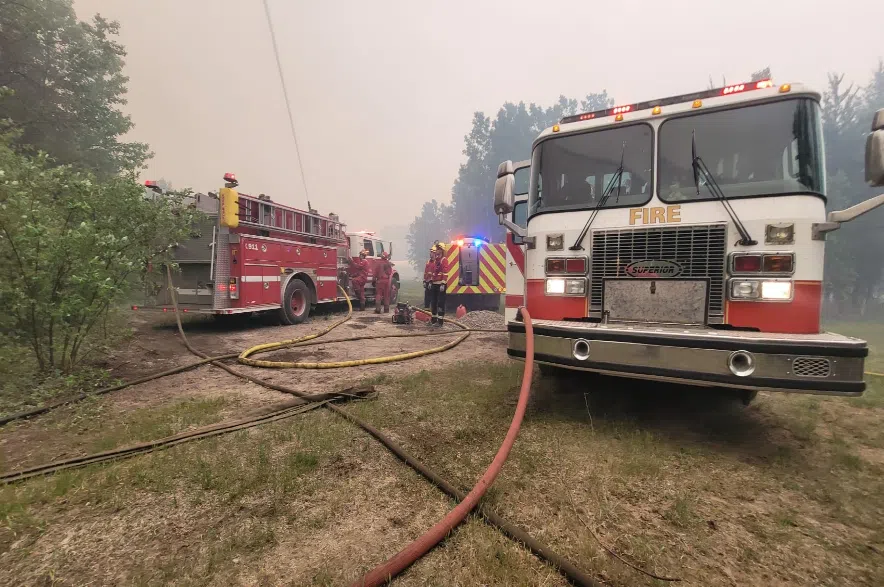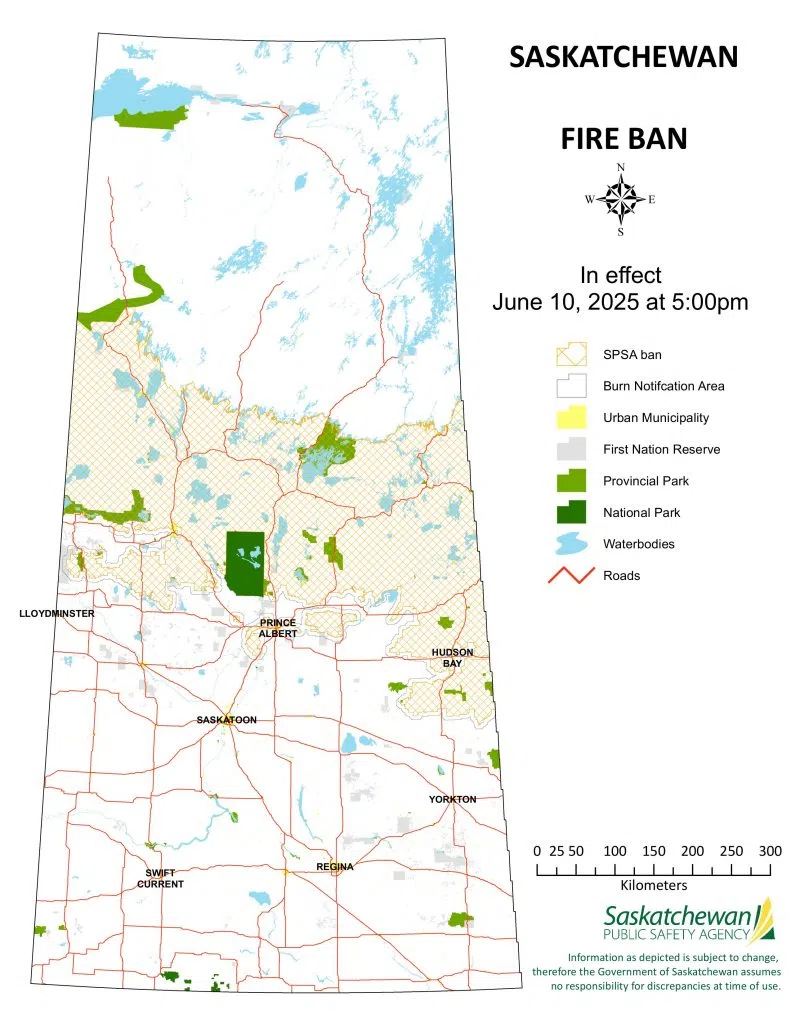There are currently 23 active wildfires in Saskatchewan; six of them are not contained.
None of the fires have experienced significant growth over the last few days.
Read more:
- Sask. wildfire evacuees to receive extra $500 in provincial funding
- Wildfires burn through 40 years of timber harvest in Saskatchewan
- Air quality warnings linger, more rain coming for wildfire areas
Executive director of land operations for the Saskatchewan Public Safety Agency (SPSA), Bryan Chartrand, said on Wednesday that things are “looking good now,” but there are a lot of large fires, and that means a lot of perimeter to monitor.
“So, it’s going to take us some time to continue to do those observations of these fires. It all depends on the weather. If it’s going to get hot and dry again, we’ll see a lot of these come back to life,” Chartrand said.
“There will be sections of these fires that will probably start smoking up throughout the summer. We’ll have to keep an eye on them. If it’s in the interior, it’s not going to be a threat, but definitely anything on the perimeters we will have to extinguish as we go forward.”
No significant fire behaviour was observed yesterday on the Shoe fire near Candle Lake, which is sitting at 550,663 hectares burned. The SPSA said 197 resources are acting on the blaze, and good progress is being made.
The Resort Village of Candle Lake said the Shoe fire is still 9 km from Highway 120 along the northeast edge of Candle Lake, but said wind direction remains favourable for SPSA firefighters.
“They report they are having good success, and as a result, SPSA has made the decision to remove values protection (pumps, hoses, sprinklers) from areas within Candle Lake. SPSA has advised they will continue adapting to changing conditions,” read the daily wildfire update online.
Provincial fire ban revised
The SPSA said the revised provincial fire ban, which came into effect Tuesday at 5 p.m., now encompasses a smaller area of the province – the area north of the provincial forest boundary, up to the Churchill River.
The fire ban continues to prohibit the use of ATVs and UTVs, any open fires, controlled burns and fireworks in the designated boundary, which includes provincial parks, provincial recreation sites and the Northern Saskatchewan Administration District within the boundary.
“Although we have seen improved fire conditions in the Far North, it is still critical that residents take every precaution to prevent wildfires,” SPSA Vice-President of Operations Steve Roberts said. “The SPSA strongly encourages all residents to do their part to prevent fire starts and for all municipalities to examine the fire risk in their area.”
Repatration efforts
SPSA president and fire commissioner Marlo Pritchard said they’ve been informed of numerous communities being either prepared for or have already repatriated back to their communities.
As of 8 a.m. Thursday, the Lac La Ronge regional emergency operations centre confirmed the lifting of the mandatory evacuation for the Lac La Ronge region.
“Little Bear Lake, Moose Horn, and Timber Bay are returning today, June 11. We’ve been informed the following communities will also be lifting evacuation orders on June 12 – Hall Lake, Brabant Lake, Nemeiban Lake, Sucker River, Wadin Bay, English Bay, Sikachu, Clam Crossing, Lac La Ronge Indian Band, La Ronge, Air Ronge, Napatak, Eagle Point, Lamp Lake, Rabbit Creek, Potato Lake. Priority 1 and Priority 2 individuals in Stanley Mission are also going to be returned in the next couple of days as repatriation efforts continue,” Pritchard said.
The Peter Ballantyne Cree Nation said residents from Pelican Narrows, Sturgeon Landing and Birch Portage have been allowed to return home. However, Denare Beach, Creighton and Flin Flon remain under an evacuation order.
The number of evacuees displaced from their homes is still being listed at around 10,000; however, that number is expected to change significantly as more residents return home in the next two days.
Earlier today, Premier Scott Moe announced those displaced by wildfires in Saskatchewan will be entitled to $500 in assistance from the province.
Other wildfires of note
The Jaysmith fire, northeast of Missinipe, is 165,328 hectares in size. Crews are working off helicopter pads on Hwy 102, and from Sucker Lake west to Copp Lake.
The Pisew fire, west of La Ronge, is measuring 181,765 hectares in size. Crews will continue patrolling, identifying hotspots and securing the fire perimeter through resource placement. Helicopters and equipment, meanwhile, will support containment efforts.
The Wolf fire, west of Denare Beach, has so far charred 135,490 hectares between Saskatchewan and Manitoba. The SPSA said crews are extinguishing hot spots around the communities and values. Helicopter support will continue bucketing where required, assisting new crews scheduled to arrive today. Further equipment is also expected to arrive.
Crews working the Pelican 2 fire, northeast of Pelican Narrows, are using pumps and hoses along the fire’s edge, putting out hotspots near helicopter pads and within the community. Work is also being done to protect Jan Lake.
At the Ditch02 fire, north of Weyakwin, crews are preparing to conduct ignition operations south of Ramsey Road to Montreal Lake. Ignition operations, also known as planned ignitions, are a fire management tactic used to strategically burn off unburned fuel between a wildfire and control lines or other desired boundaries. Crews will begin opening up Highway 969 to Molanosa.
Year to date, there have been 259 wildfires in Saskatchewan; that’s compared to 174 at the same time last year and the five-year average of 147. A total of 290 values, like vehicles or cabins, have been confirmed lost by wildfires, but it’s believed the number is closer to 400.













